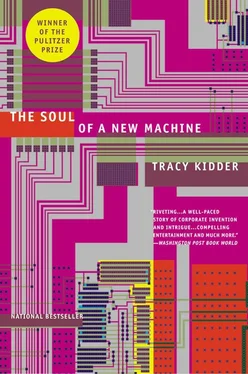The people who shared the journey remembered West. The following winter, describing the nasty northeaster over dinner, the captain remarked, “That fellow West is a good man in a storm.” The psychologist did not see West again, but remained curious about him. “He didn’t sleep for four nights! Four whole nights .” And if that trip had been his idea of a vacation, where, the psychologist wanted to know, did he work?
1
HOW TO MAKE A LOT OF MONEY
For a time after the first pieces of Route 495 were laid down across central Massachusetts, in the middle 1960s, the main hazard to drivers was deer. About fifteen years later, although traffic went by in processions, stretches of the highway’s banks still looked lonesome. Driving down 495, you passed some modern buildings, but they quickly disappeared and then for a while there would be little to see except the odd farmhouse and acres of trees. The highway traverses some of the ghost country of rural Massachusetts. Like Troy, this region contains evidence of successive sackings: in the pine and hardwood forests, which now comprise two-thirds of the state, many cellar holes and overgrown stone walls that farmers left behind when they went west; riverside textile mills, still the largest buildings in many little towns, but their windows broken now, their machinery crumbling to rust and the business gone to Asia and down south. However, on many of the roads that lead back behind the highway’s scenery stand not woods and relics, but brand-new neighborhoods, apartment houses, and shopping centers. The roads around them fill up with cars before nine and after five. They are going to and from commercial buildings that wear on their doors and walls descriptions of new enterprise. Digital Equipment, Data General—there on the edge of the woods, those names seemed like prophecies to me, before I realized that the new order they implied had arrived already.
A few miles north of the junction of Route 495 and the Massachusetts Turnpike, off an access road, sits a two-story brick building, surrounded by parking lots. A sign warns against leaving a car there without authority. The building itself looks like a fort. It has narrow windows, an American flag on a pole out front, a dish antenna on a latticed tower. Mounted on several corners of the roofs, and slowly turning, are little TV cameras.
This is Building 14A/B—14B was fastened seamlessly to 14A. Some employees call the place “Webo,” but most refer to it as “Westborough,” after the name of the town inside whose borders the building happens to exist. “Westborough” is worldwide headquarters of the Data General Corporation. Driving up to the building one day with one of the company’s public relations men, I asked, “Who was the architect?”
“We didn’t have one!” cried the beaming press agent.
Company engineers helped to design Westborough, and they made it functional and cheap. One contractor who did some work for Data General was quoted in Fortune as saying, “What they call tough auditing, we call thievery.” However they accomplished it, Westborough cost only about nineteen dollars a square foot at a time when the average commercial building in Massachusetts was going for something like thirty-four dollars a foot. But looks do matter here. The company designed Westborough not just for the sake of thriftiness, but also to make plain to investors and financial analysts that Data General really is a thrifty outfit. “There’s no reason in our business to have an ostentatious display,” a company analyst for investor relations explained. “In fact, it’s detrimental.”
The TV cameras on the roofs, the first defense against unscrupulous competitors and other sorts of spies and thieves, must comfort those who have a stake in what goes on inside. As for me, I imagined that somewhere in the building men in uniforms were watching me arrive, and I felt discouraged from walking on the grass.
The only door that opens for outsiders leads to the front lobby. A receptionist asks you to sign a logbook, which inquires if you are an American citizen, wants your license plate number, and so on. Still you cannot pass the desk and enter the hallways beyond—not until the employee you want to see comes out and gives you escort. When I inquired, the cheerful young receptionist said that once in a great while some outsider would try to break the rules and try to slip inside.
The lobby could belong to a motor inn. It has orange carpeting and some chairs and a sofa upholstered in vinyl, on which salesmen and would-be employees languish, awaiting appointments. Now and then, a visitor will stand and gaze into a plastic case. It contains the bare bones of a story that will feed the dreams of any ambitious businessman. THE FIRST NOVA, reads a legend on the case. Inside sits a small computer, about the size of a suitcase, with a cathode-ray tube—a thing like a television screen—beside it. A swatch of prose on the back wall, inside the case, explains that this was the first computer that Data General ever sold. But the animal in there isn’t stuffed; the computer is functioning, lights on it softly blinking as it produces on the screen beside it a series of graphs—ten years’ worth of annual reports, a précis of Data General Corporation’s financial history.
Left to their own devices, the engineers who worked in the basement of Building 14A/B could surely have produced a flashier display, but a visitor from Wall Street who had never paid attention to this company before might have felt faint before the thing. The TV screen was blue. The graphs, etched in white, appeared in rotating sequence, and each one bore a name. “Cumulative Computers Shipped Since Our Founding” started with 100 in 1969 and went right up to 70,700 in 1979. The image vanished. “Net Sales” appeared, to show that revenues had ascended without a hitch from nothing in 1968 to $507.5 million in 1979. That graph went away and in its place came one describing profit margins. These hardly varied. The profits just rolled in, year after year, along a nearly straight line, at about 20 percent (before taxes) of those burgeoning net sales.
Someone unaccustomed to reading financial reports might have missed the full import of the numbers on the screen, the glee and madness in them. But anyone could see that they started small and got big fast. Mechanically, monotonously, the computer in the case was telling an old familiar story—the international, materialistic fairy tale come true.
The first modern computers arrived in the late 1940s, and although many more or less single-handed contributions fostered the technology, they did so mainly in the shade of a familiar association in America among the military, universities and corporations. On the commercial side, IBM quickly established worldwide hegemony; it brought to computers the world’s best sales force, all dressed in white shirts and blue suits. For some years the computer industry consisted almost exclusively of IBM and several smaller companies—“IBM and the seven dwarfs,” business writers liked to say. Then in the 1960s IBM produced a family of new computers, called the 360 line. It was a daring corporate undertaking. “We’re betting the company,” one IBM executive remarked. Indeed, the project cost somewhat more than the development of the atom bomb, but it paid off handsomely. It guaranteed for a long time to come IBM’s continued preeminence in the making of computers for profit. Meanwhile, though, new parts of the business were growing up, and out from under IBM.
In the early days, computers inspired widespread awe and the popular press dubbed them giant brains. In fact, the computer’s power resembled that of a bulldozer; it did not harness subtlety, though subtlety went into its design. It did mainly bookkeeping and math, by rote procedures, and it did them far more quickly than they had ever been done before. But computers were relatively scarce, and they were large and very expensive. Typically, one big machine served an entire organization. Often it lay behind a plate glass window, people in white gowns attending it, and those who wished to use it did so through intermediaries. Users were like supplicants. The process could be annoying.
Читать дальше











